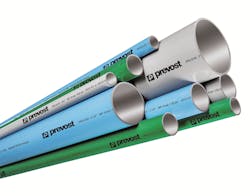Tool Review: Prevost Piping System
When it comes to designing and installing compressed air piping networks, having the ability to quickly add and change parts easily as you go is a huge time saver in getting the job done. Scott Casper, owner of Compressed Air Pros in Winston Salem, North Carolina, says he prefers using the Prevost Piping System for such jobs.
“The system is well designed and the cost is the most competitive,” Casper says. “I can design the system while understanding that it is easy to add onto or change.”
Casper has installed the Prevost Piping System in various locations that need compressed air, including automotive service departments, tire service facilities, collision centers, tractor and farm equipment service centers, and industrial manufacturing facilities.
Casper purchases the Piping System components individually for the most part, although he does like to keep some of the more common parts such as pipe, elbows, unions, tapping flange, some manifolds, and a few threaded unions on-hand in inventory.
When the components arrive, the pipes come in bundles of ten inside a cardboard tube, which is then enclosed with wood for extra protection during shipping; the fittings come individually packed in their own separate box.
At the start of every installation, Casper first draws an outline on where he wants to place the loop system. This includes determining the best method for fastening or hanging the system from the walls and/or ceiling to keep the pipe level, so the pipe doesn’t have to go up and down or around obstacles within the building.
After the hangers are in place, he starts with the pipe. He lays out the corners of the header, squares them up, and then it’s just a matter of filling in the blank areas with pipe, ball valves, and unions, he notes.
“It’s simple to cut the pipe, deburr, and chamfer the outside edge, [then] slip on the fitting, and tighten,” Casper says. “There is no messy thread sealant, no trying to line up threaded pipe, or twist 20’ pipe way up in the air on a lift or ladder. There is no soldering and trying to make sure the joint is completely secure without a leak.”
There is also no open flame involved, decreasing the risk to the installer or any surrounding equipment, he adds.
One of Casper’s favorite components to install is the tapping flange. The PPS1 BP2520, or one that is similar, is “by far the best designed way to install a drop header and/or loop network.”
In Casper’s experience, he prefers Prevost’s Piping System over other brands he has used. In particular, he states the new PPS1 fittings are stronger and connect easily, the clamps are sturdy, the tapping flanges are easy to line up, and there is a vast array of different styles and sizes of fittings available.
In addition to the clamps being sturdy, Prevost has redesigned the clamps to fit 3/8” threaded rod. Casper says this feature has been “a blessing” to simplify the installations even more, since most hanging clips and fasteners from suppliers use a 3/8” threaded connection.
Overall, Casper thoroughly enjoys using the Prevost Piping System.
The Prevost Piping System is a compressed air network range made of compact, lightweight, impact-resistant pipes and fittings made entirely from aluminum. The Piping System offers a leak-free network that is easy to assemble. The aluminum alloy used, combined with epoxy paint on the outside and a treatment on the inside, protects the pipe against the risks of oxidation and corrosion. This system comes equipped with the "PPS Grip Concept" to ensure a good connection and no leaks. Flow rates are optimized thanks to a smooth internal pipe surface, a low friction coefficient, and a large diameter.
About the Author
Kayla Oschmann
Assistant Editor | Vehicle Repair Group
Kayla Oschmann is assistant editor for the Vehicle Repair Group.
With an education in journalism and public relations, Oschmann contributes to Fleet Maintenance, PTEN, and Professional Distributor magazines, as well as VehicleServicePros.com.

